Related Research Articles

Hot Jupiters are a class of gas giant exoplanets that are inferred to be physically similar to Jupiter but that have very short orbital periods. The close proximity to their stars and high surface-atmosphere temperatures resulted in their informal name "hot Jupiters".

HAT-P-2b is an extrasolar planet detected by the HATNet Project in May 2007. It orbits a class F star HAT-P-2,, located about 420 light-years away in the constellation Hercules.

TrES-4b is an extrasolar planet, and one of the largest exoplanets ever found, after WASP-12b, WASP-17b, CT Chamaeleontis b, GQ Lupi b and HD 100546 b. It was discovered in 2006, and announced in 2007, by the Trans-Atlantic Exoplanet Survey, using the transit method. It is approximately 1,400 light-years (430 pc) away orbiting the star GSC 02620-00648, in the constellation Hercules.

HAT-P-4b is a confirmed extrasolar planet orbiting the star HAT-P-4 over 1000 light years away in Boötes constellation. It was discovered by transit on October 2, 2007, which looks for slight dimming of stars caused by planets that passed in front of them. It is the fourth planet discovered by the HATNet Project. It is also called BD+36 2593b, TYC 2569-01599-1b, 2MASS J15195792+3613467b, SAO 64638b.

WASP-3b is an extrasolar planet orbiting the star WASP-3 located approximately 800 light-years away in the constellation Lyra. It was discovered via the transit method by SuperWASP, and follow up radial velocity observations confirmed that WASP-3b is a planet. The planet's mass and radius indicate that it is a gas giant with a similar bulk composition to Jupiter. WASP-3b has such an orbital distance around its star to classify it in the class of planets known as hot Jupiters and has an atmospheric temperature of approximately 1983 K.

WASP-4b is an extrasolar planet approximately 891 light-years away in the constellation of Phoenix.
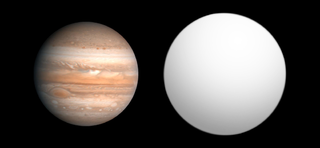
WASP-5b is an extrasolar planet orbiting the star WASP-5 located approximately 1000 light-years away in the constellation Phoenix. The planet's mass and radius indicate that it is a gas giant with a similar bulk composition to Jupiter. The small orbital distance of WASP-5 b around its star mean it belongs to a class of planets known as hot Jupiters. The equilibrium planetary temperature would be 1717 K, but measured in 2015 temperature was still much higher at 2500±100 K. Dayside temperature measured in 2020 was 2000±90 K.
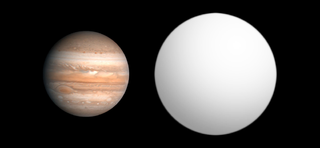
HAT-P-7b is an extrasolar planet discovered in 2008. It orbits very close to its host star and is larger and more massive than Jupiter. Due to the extreme heat that it receives from its star, the dayside temperature is predicted to be 2,630–2,880 K K, while nightside temperatures are 2,211–2,238 K. HAT-P-7b is also one of the darkest planets ever observed, with an albedo of less than 0.03—meaning it absorbs more than 97% of the visible light that strikes it.

WASP-6b, also named Boinayel, is an extrasolar planet approximately 600 light years away in the constellation Aquarius. It was discovered in 2008, by the WASP survey, by astronomical transit across its parent star WASP-6. This planet orbits only 4% that of Earth-Sun distance. The planet has mass half that of Jupiter, but its insolation has forced a thermal expansion of its radius over that of Jupiter. The planet is an inflated Hot Jupiter. Starspots on the host star WASP-6 helped to refine the measurements of the mass and the radius of the planet.
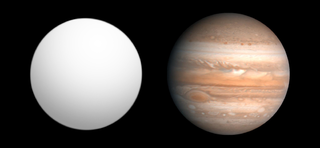
WASP-7b is an extrasolar planet discovered in 2008. This 5-day period planet is slightly smaller than Jupiter, roughly the same mass and more dense.

HAT-P-9b, formally named Alef, is an exoplanet approximately 1500 light years away in the constellation Auriga. This planet was found by the transit method on June 26, 2008. It has a mass 78% that of Jupiter and a radius 140% that of Jupiter. As with most transiting planets, this planet is a hot Jupiter, meaning this Jupiter-like planet orbits extremely close to its parent star, taking only 3.92 days to orbit.
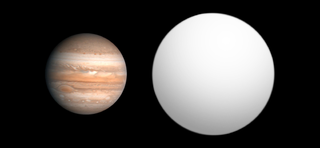
HAT-P-8b is an extrasolar planet located approximately 720 light years away in the constellation of Pegasus, orbiting the 10th magnitude star GSC 02757-01152. This planet was discovered by transit on December 5, 2008. Despite the designation as HAT-P-8b, it is the 11th planet discovered by the HATNet Project. The mass of the planet is 50% more than Jupiter while the radius is also 50% more than Jupiter. The mass of this planet is exact since the inclination of the orbit is known, typical for transiting planets. This is a so-called “hot Jupiter” because this Jupiter-like gas giant planet orbits in a really close torch orbit around the star, making this planet extremely hot. The distance from the star is roughly 20 times smaller than that of Earth from the Sun, which places the planet roughly 8 times closer to its star than Mercury is from the Sun. The “year” on this planet lasts only 3 days, 1 hour, 49 minutes, and 54 seconds, compared with Earth's 365 days, 6 hours, 9 minutes, and 10 seconds in a sidereal year.

WASP-17b is an exoplanet in the constellation Scorpius that is orbiting the star WASP-17. Its discovery was announced on 11 August 2009. It is the first planet discovered to have a retrograde orbit, meaning it orbits in a direction counter to the rotation of its host star. This discovery challenged traditional planetary formation theory. In terms of diameter, WASP-17b is one of the largest exoplanets discovered and at half Jupiter's mass, this made it the most puffy planet known in 2010. On 3 December 2013, scientists working with the Hubble Space Telescope reported detecting water in the exoplanet's atmosphere.
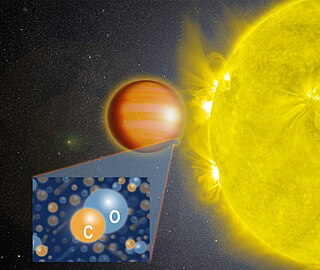
WASP-18b is an extrasolar planet that is notable for having an orbital period of less than one day. It has a mass equal to 10 Jupiter masses, just below the boundary line between planets and brown dwarfs. In 2023, the James Webb Space Telescope discovered traces of water in the planet. Due to tidal deceleration, it is expected to spiral toward and eventually merge with its host star, WASP-18, in less than a million years. The planet is approximately 3.1 million km from its star, which is about 410 light-years from Earth. A team led by Coel Hellier, a professor of astrophysics at Keele University in England, discovered the exoplanet.

Kepler-8b is the fifth of the first five exoplanets discovered by NASA's Kepler spacecraft, which aims to discover planets in a region of the sky between the constellations Lyra and Cygnus that transit their host stars. The planet is the hottest of the five. Kepler-8b was the only planet discovered in Kepler-8's orbit, and is larger than Jupiter. It orbits its host star every 3.5 days. The planet also demonstrates the Rossiter–McLaughlin effect, where the planet's orbit affects the redshifting of the spectrum of the host star. Kepler-8b was announced to the public on January 4, 2010 at a conference in Washington, D.C. after radial velocity measurements conducted at the W.M. Keck Observatory confirmed its detection by Kepler.
WASP-33b is an extrasolar planet orbiting the star HD 15082. It was the first planet discovered to orbit a Delta Scuti variable star. With a semimajor axis of 0.026 AU and a mass likely greater than Jupiter's, it belongs to the hot Jupiter class of planets.
HAT-P-32b is a planet orbiting the G-type or F-type star HAT-P-32, which is approximately 950 light years away from Earth. HAT-P-32b was first recognized as a possible planet by the planet-searching HATNet Project in 2004, although difficulties in measuring its radial velocity prevented astronomers from verifying the planet until after three years of observation. The Blendanal program helped to rule out most of the alternatives that could explain what HAT-P-32b was, leading astronomers to determine that HAT-P-32b was most likely a planet. The discovery of HAT-P-32b and of HAT-P-33b was submitted to a journal on 6 June 2011.
HAT-P-24b is an extrasolar planet discovered by the HATNet Project in 2010 orbiting the F8 dwarf star HAT-P-24. It is a hot Jupiter, with a mass three quarters that of Jupiter and a radius 20% larger.
Kepler-13 or KOI-13 is a stellar triple star system consisting of Kepler-13A, around which an orbiting hot Jupiter exoplanet was discovered with the Kepler spacecraft in 2011, and Kepler-13B a common proper motion companion star which has an additional star orbiting it.
HD 146389, is a star with a yellow-white hue in the northern constellation of Hercules. The star was given the formal name Irena by the International Astronomical Union in January 2020. It is invisible to the naked eye with an apparent visual magnitude of 9.4 The star is located at a distance of approximately 446 light years from the Sun based on parallax, but is drifting closer with a radial velocity of −9 km/s. The star is known to host one exoplanet, designated WASP-38b or formally named 'Iztok'.
References
- 1 2 3 4 5 6 7 Bonomo, A. S.; Hébrard, G.; Santerne, A.; Santos, N. C.; Deleuil, M.; Almenara, J.; Bouchy, F.; Díaz, R. F.; Moutou, C.; Vanhuysse, M. (2012). "SOPHIE velocimetry of Keplertransit candidates". Astronomy & Astrophysics. 538: A96. arXiv: 1110.5462 . Bibcode:2012A&A...538A..96B. doi:10.1051/0004-6361/201118323. S2CID 118528032.
- 1 2 A Comprehensive Study of Kepler Phase Curves and Secondary Eclipses:Temperatures and Albedos of Confirmed Kepler Giant Planets
- ↑ Albrecht, Simon; Winn, Joshua N.; Johnson, John A.; Howard, Andrew W.; Marcy, Geoffrey W.; Butler, R. Paul; Arriagada, Pamela; Crane, Jeffrey D.; Shectman, Stephen A.; Thompson, Ian B.; Hirano, Teruyuki; Bakos, Gaspar; Hartman, Joel D. (2012), "Obliquities of Hot Jupiter Host Stars: Evidence for Tidal Interactions and Primordial Misalignments", The Astrophysical Journal, 757 (1): 18, arXiv: 1206.6105 , Bibcode:2012ApJ...757...18A, doi:10.1088/0004-637X/757/1/18, S2CID 17174530